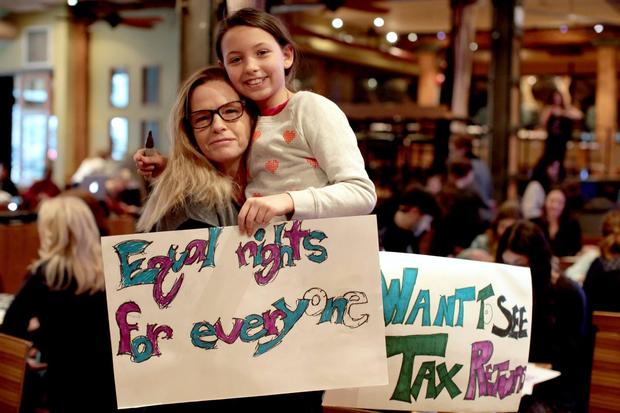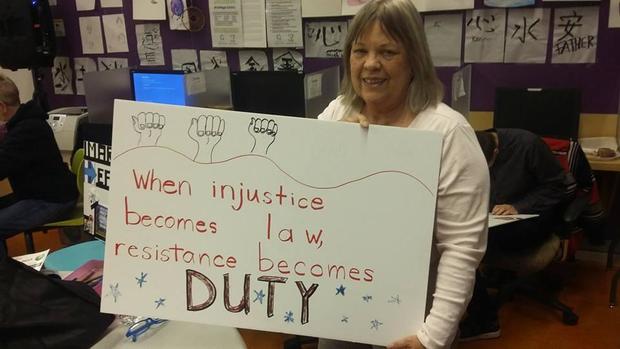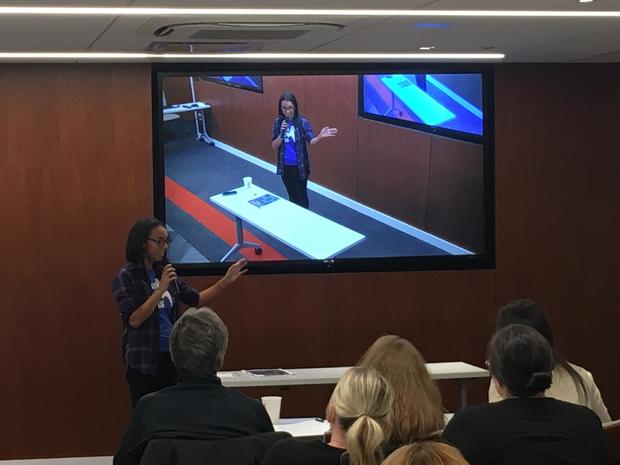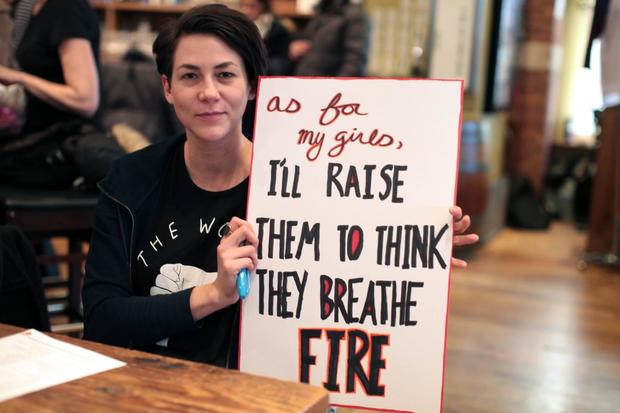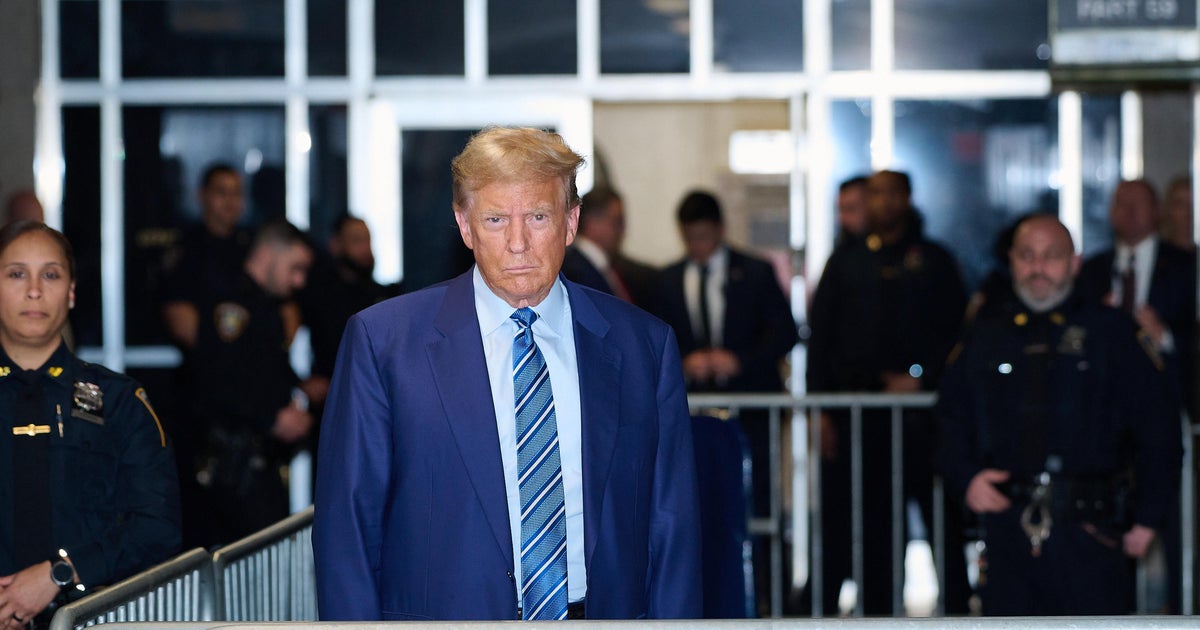Meet the women of the Women's March on Washington
Having travelled across the country by plane, train, bus, car and foot, hundreds of thousands of women are flocking to the nation’s capital this weekend to storm the National Mall.
They are not there for the Presidential Inauguration, but many say they have a message for Donald Trump’s America.
Conceived in the late hours of election night, the Women’s March on Washington all began with a frustrated Facebook post by Hawaii grandmother Teresa Shook. “What if women marched on Washington around Inauguration Day en masse?” she wrote on her wall.
A few hours later, the social media thought bubble was transformed into a Facebook event page. More and more began clicking the link. As it turns out, Shook was not the only disgruntled voter searching for a new cause.
For many rooting for a female president, the pain of Hillary Clinton’s defeat could only be expressed in physical terms. “I felt like I was kicked in the crotch, honestly,” notes school psychologist Dawn Houpe, who texted her teenage daughters words of encouragement throughout election night.
As Rust-Belt states turned red, Houpe’s pain worsened.
“I felt as a woman like I had just been sucker-punched,” admits the breast-cancer survivor from South Carolina. “That’s exactly what it felt like.”
“I felt like I had a hangover the next day,” Denise Valkyrie of Bloomington, Indiana explains of watching her governor become vice president. “It was just an awful, awful feeling.”
When Valkyrie spotted the Women’s March post, she created a new Facebook event for Hoosiers interested in travelling down to Washington together. “I tagged forty of my friends to see if they were interested. I woke up and 500 people had joined. Those forty had asked another forty, and it just kept snowballing.”
Phoebe Hopps founded the Michigan chapter for the Women’s March. “I woke up the day after the election feeling like I got hit by a bus,” she recalls. “So I flipped on my computer and saw that several people were organizing a march.”
The full-time project manager needed to get her mind off things. “I thought if I get involved in this and create the Michigan page, it might distract me from how I’m feeling. And it might turn fear into hope.”
Minnesotan Gloria Everson says she was looking forward to toasting a female president-elect on her birthday, just two days post-election. After scrolling through birthday messages, she also spotted a friend’s Facebook post about the protest.
“The next day, I did a search to see if there were any Minnesota groups planning for the March,” the former college professor says. “I threw a page up and within three hours, the national team contacted me.”
Erin Barnett remembers November 10th, too. “I’d spent the last two days in grief, lying in my bed,” the 41-year old consultant from Eugene, Oregon admits.
Barnett says she felt a fire light up inside her as she logged into her social media account. “I was flipping through my Facebook on my phone and spotted this event,” Barnett says. “I scrolled through and didn’t see any volunteers from Oregon, so I raised my hand.”
And so it began. Hillary voters from across the country logged into Facebook hoping to commiserate with friends. What they found was a reason to get back on their feet.
The national team behind the Women’s March on Washington began assembling a team of state coordinators to help rally troops of protesters from all 50 states. “The call to action was posted on November 9th,” says Colorado state-coordinator Kenzie Rodriguez. “By November 10th, we had 40 states pledged to organize a march in their state and to come to DC.”
Rodriguez attests she has not put down her phone in days. “It’s just constant phone calls, Facebook messages, emails,” she says giddily. “It’s been insane.”
Nevada state coordinator Jean Dunbar was shocked by the enthusiasm, adding that their event page nearly “melted down with posts.” What began as a light “after-work” task soon became another full-time job.
“The typical day does not end for me. It goes until the next day,” Dunbar says with a laugh. “If you looked at the time stamps in my inbox, you might think I was three people.”
“For the past month, I’ve been working non-stop,” Sandy Motaert of Cedar Rapids, Iowa says. “I start at 8 a.m., and I’m lucky if I get off at 11 p.m.”
Michigan coordinator Phoebe Hopps took time off from work to commit full-time to the march. “I didn’t realize I was going to be working 16-18 hours a day on this,” she jokes. “Even on Christmas day…It’s non-stop. Every minute.”
Sister Barbara Battista of Terre Haute, Indiana had made arrangements in the summer to attend what she thought would be Hillary Clinton’s inauguration.
“Obviously, those plans changed,” the Catholic nun said. “But then I realized, I got some time and energy. I want to do something positive.”
She first heard about the Women’s March in late November: “I started planning to drive out there with a few people, and then I just started spreading the word.” Soon, her carpool went from a mini-van to 25-passenger bus to an even bigger vehicle. March coordinators from Indiana began assembling a fleet of buses, and estimate more than 5,000 people will be travelling down to the march from the Hoosier state.
Though participant counts are difficult to gage, some state coordinators have pulled all-nighters helping to coordinate carpools. Virginia transportation coordinator Reagan Flaherty has booked 125 buses to bring marchers from her neighbor state, and anticipates at least 15,000 Virginians will attend.
At least 1,000 participants are flying in from Oregon. The state’s chapter Facebook page filled up with posts about Southwest airline deals beginning in November. Amtrak has added two entirely new trips and additional train cars onto existing trips to meet the demand of marchers travelling down from New York City.
New York state even set up a ride-sharing website set up to help marchers connect with others driving to Washington, and organizers estimate more than 350 buses will be travelling down to the capitol on Friday.
Approximately 200 marchers are making the more than 10-hour plane journey from Hawaii. Groups of Californians boarded buses earlier in the week for a cross-country road trip. And the deep-red state of South Carolina has organized 22 buses, but anticipates over 3,000 participants are headed to the March.
The Massachusetts chapter raised over $30,000 to fund travel for 130 women and allies who otherwise would not be able to afford the trek. “From the get-go, we focused on being inclusive and ensuring that diverse voices were able to get to DC,” says lead-coordinator for Massachusetts, Tami Gouveia. “We have sponsored bus tickets from families who have lost children to gun violence.”
The Indiana state chapter sold 500 scarves with the Women’s March logo to raise money for women who could not afford bus tickets down to the march.
They’re not the only state with a delegation donning matching attire. Oregonians are wearing beanies with angel wing embroidery. They’ve appropriated the Oregon state motto—“she flies with her own wings” -- on signs and hats. Meanwhile, the Minnesota chapter partnered with a local women-run business to produce t-shirts and sweatshirts with the Women’s March logo.
Yet perhaps the most popular item to be worn Saturday is a pink knit hat with cat ears. “It’s called the pussy-hat project,” says Iowa state coordinator Sandy Motaert. “We have tons of knitting groups that are making these hats.”
The pussy-hat project began in late November, originating in an L.A. based knit shop. Some yarn shops across the country have reported selling out of pink yarn. Washington, D.C.’s “Loop Yarn Works” is no exception.
“Pink yarn stays on the shelf for 24 hours,” Jessica Boudreau, the store manager, says. “Forty-eight hours tops…I can’t even post pink yarn pictures on Instagram. By the time I upload the pictures, we’ve sold out of yarn.”
“Everyone is wearing these pink knitted hats,” Phoebe Hopps, the founder of the Michigan chapeter, says. “My friends and I, we have matching ones. We’re going to Sephora to buy matching lipsticks later today.”
Back in Iowa, so many yarn stores sold out of pink skeins, marchers began stitching felt pussy hats as a substitute. Participants are also receiving cap donations.
“A lot of elderly women at home are volunteering to knit these hats,” Sandy Motaert of Iowa explains. “They can’t march, but they’re still doing their part by donating.”
“There have been people furiously, furiously knitting,” says Tami Gouveia. “I ended up with 42 of these hats. I gave them away to our leadership team.”
Each hat is made with cat ears, though the name “pussy-hat” was inspired by Donald Trump’s 2005 comments in a leaked Access Hollywood video.
Hat or no hat, not all marchers are taking direct aim at the new president. “One thing we’re not doing is trash talking Donald Trump,” says Alabaman Deborah Barros-Smith. “Dumping on him isn’t going to get us anywhere.”
Barros-Smith is worried about policy, not politics. “I am personally a recipient of Obamacare,” she explains. “We cannot let women be bystanders and watch our healthcare be stripped away.”
“I think Donald Trump was the spark that lit a fire,” Erin Barnhart says. “The tinder and fuel was there all along.”
“It is not an anti-Trump march,” proclaims South Carolina state coordinator Hayne Beattie-Gray.
“Donald Trump would love for nothing else than for hundreds of thousands of women to chant his name in the capital on Saturday,” she laughs. The mother of three is taking her 12-year old daughter, Isabel, to visit D.C. for the first time. She says she’s teaching her daughter about a greater theme: “Together, we are stronger.”
Dawn Houpe is also bringing her two daughters to the march. Her eldest daughter Rose, 20, is hopping on the Greenville bus from Clemson University, while younger daughter Lilly, 16 rides with Mom from Charleston to Washington DC.
“I’m looking forward to my daughters participating in something historical like this,” Houpe beams. “I’m looking forward to solidarity with women of all faith, color, ethnicity. And to experience that with my children.”
Khadijah Shareef, a food truck operator from Indianapolis, says she is marching for those who feel like they no longer belong in the United States.
“Being African American, Muslim, and a woman, I am fighting for everyone on the list,” she says. Shareef says hardest part of the campaign cycle was confronting elementary school students who asked her if they needed to take off their hijabs. It broke her heart.
“For me it was about making sure I did not miss an opportunity to stand up for women’s rights, for our rights that may be trampled on, for women’s rights, for equal rights for all of us.”
These activists from across the country are already planning post-march events, in an effort to keep the ball rolling.
Hayne Beattie-Gray, who also helped lead the National Youth Team Initiative for the March, has already planned town hall sessions in three South Carolina cities come February. “While the 21st is such an important kickoff event, it’s really important to take that energy and bring it back home,” she says.
Others are thinking beyond 2017 about ways to shake up their offices and government. “When Hillary Clinton lost, it made me realize that’s one small piece of it,” Kenzie Rodriguez said. “When I look around me, I see so many powerful female leaders and I don’t see that reflected at my office, in the board room.
I don’t see that reflected in the Congress. And I certainly don’t see that reflected in the office of the Presidency.”
